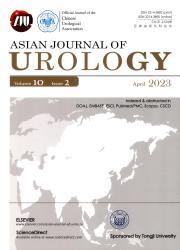Evaluating the concordance between Vesical Imaging Reporting and Data System scores and bladder tumor histopathology
IF 2.4
3区 医学
Q2 UROLOGY & NEPHROLOGY
引用次数: 0
Abstract
Objective
This study aimed to assess the local staging of bladder tumors in patients utilizing preoperative multiparametric MRI (mpMRI) and to demonstrate the clinical efficacy of this method through a comparative analysis with corresponding histopathological findings.
Methods
Between November 2020 and April 2022, 63 patients with a planned cystoscopy and a preliminary or previous diagnosis of bladder tumor were included. All participants underwent mpMRI, and Vesical Imaging Reporting and Data System (VI-RADS) criteria were applied to assess the recorded images. Subsequently, obtained biopsies were histopathologically examined and compared with radiological findings.
Results
Of the 63 participants, 60 were male, and three were female. Categorizing tumors with a VI-RADS score of >3 as muscle invasive, 84% were radiologically classified as having an invasive bladder tumor. However, histopathological results indicated invasive bladder tumors in 52% of cases. Sensitivity of the VI-RADS score was 100%; specificity was 23%; the negative predictive value was 100%; and the positive predictive value was 62%.
Conclusion
The scoring system obtained through mpMRI, VI-RADS, proves to be a successful method, particularly in determining the absence of muscle invasion in bladder cancer. Its efficacy in detecting muscle invasion in bladder tumors could be further enhanced with additional studies, suggesting potential for increased diagnostic efficiency through ongoing research. The VI-RADS could enhance the selection of patients eligible for accurate diagnosis and treatment.
评估膀胱造影报告和数据系统评分与膀胱肿瘤组织病理学之间的一致性
目的应用术前多参数MRI (mpMRI)评估膀胱肿瘤的局部分期,并与相应的组织病理学结果进行对比分析,证明该方法的临床疗效。方法在2020年11月至2022年4月期间,纳入63例计划膀胱镜检查并初步或先前诊断为膀胱肿瘤的患者。所有参与者都接受了mpMRI检查,并应用膀胱成像报告和数据系统(VI-RADS)标准评估记录的图像。随后,对获得的活组织切片进行组织病理学检查,并与放射学结果进行比较。结果在63名参与者中,60名男性,3名女性。将VI-RADS评分为>;3的肿瘤分类为肌肉浸润性肿瘤,84%的肿瘤放射学分类为浸润性膀胱肿瘤。然而,组织病理学结果显示浸润性膀胱肿瘤占52%。VI-RADS评分敏感性为100%;特异性为23%;阴性预测值为100%;阳性预测值为62%。结论通过mpMRI获得的评分系统VI-RADS是一种成功的方法,特别是在判断膀胱癌是否有肌肉侵犯方面。它在检测膀胱肿瘤肌肉侵袭方面的功效可以通过进一步的研究进一步增强,这表明通过正在进行的研究有可能提高诊断效率。VI-RADS可以提高对患者的选择,使其能够得到准确的诊断和治疗。
本文章由计算机程序翻译,如有差异,请以英文原文为准。
求助全文
约1分钟内获得全文
求助全文
来源期刊

Asian Journal of Urology
UROLOGY & NEPHROLOGY-
CiteScore
4.00
自引率
3.80%
发文量
100
审稿时长
4 weeks
期刊介绍:
Asian Journal of Urology (AJUR), launched in October 2014, is an international peer-reviewed Open Access journal jointly founded by Shanghai Association for Science and Technology (SAST) and Second Military Medical University (SMMU). AJUR aims to build a communication platform for international researchers to effectively share scholarly achievements. It focuses on all specialties of urology both scientifically and clinically, with article types widely covering editorials, opinions, perspectives, reviews and mini-reviews, original articles, cases reports, rapid communications, and letters, etc. Fields of particular interest to the journal including, but not limited to: • Surgical oncology • Endourology • Calculi • Female urology • Erectile dysfunction • Infertility • Pediatric urology • Renal transplantation • Reconstructive surgery • Radiology • Pathology • Neurourology.
 求助内容:
求助内容: 应助结果提醒方式:
应助结果提醒方式:


